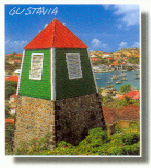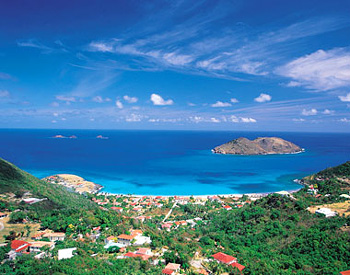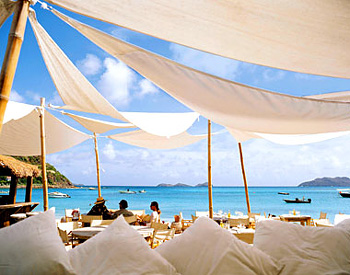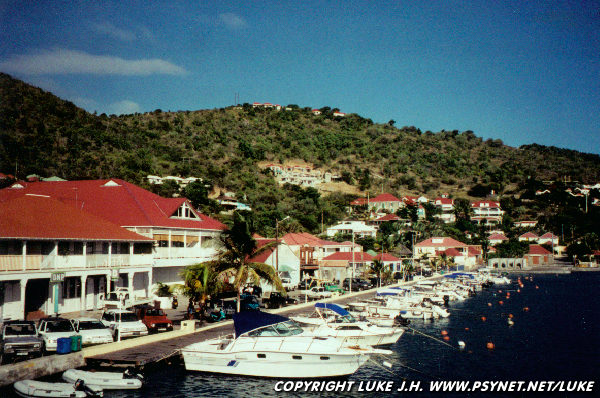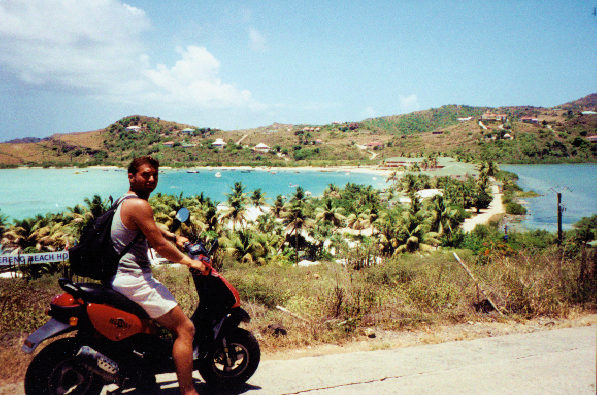
Navigator Christopher Columbus was 41 years old when he set out on his first voyage to the new world. For many years he had honed the art of navigation on European seas, while at the same time learning the disciplines of geography and cartography. For this explorer born in Genoa, Italy, one thing was certain: the world was round. By setting sail on the ocean to the west of Europe, and following the setting sun, he thought he would eventually get to the East Indies. To make his voyage possible, he needed patrons. His search took him to Spain where he presented his project to King Ferdinand and Queen Isabelle. On August 3, 1492, his three ships set sail… these European sovereigns had given him the support he needed. Navigating toward the unknown, in the midst of a tempest at sea, he eventually discovered the Bahamas, Haiti, and Santo Domingo before returning home to Europe. During his second voyage in 1493, he discovered the Lesser Antilles chain of islands, including Ouanalao, a small, scrubby island frequented by the Carib Indians. Christopher Columbus renamed this tiny island with the name of his brother, Bartholoméo. The island proved of no interest to those early colonists who were in search of new continents rich with gold and other treasures, so Columbus left the island behind and went on to other discoveries.
Several different ethnic groups, the Amerindians, Caribs, Arawaks, and Tanios, tried to defend their small territories, but faced with the European colonists, the battle could only be lost. Modern weapons of the period quickly crushed their primitive war clubs and small hatchets made from conch shells. It wasn’t until 1648 that Monsieur de Longvilliers de Poincy decided to colonize the island of Saint Barthélemy. He sent Sir Jacques Gente with 40 or 50 men to establish a settlement. This small colony grew with the addition of some residents from Saint Kitts, most notably a certain Lord Bonhomme.
Photo Copyright © CoblentzBut after the bloody massacre of these first European inhabitants by the Carib Indians in 1656 (they frequently visited the island), Saint Barthélemy was abandoned. Those who were able to escape the terror of these attacks had no desire to return. In 1659, peace was made, and Monsieur de Poincy once again sent a group of 30 men. By 1664, the colony had grown to a population of 100.
Saint Barthélemy was made a possession of The Order of Malta by the West Indies Company in 1665, but in 1666 all of the inhabitants were sent to Saint Kitts against their wishes, as a new Irish colony was established. This attempt was a failure as the inhabitants of Saint Barth quickly returned to claim their lands.
Photo Copyright © LagneseBy 1674, the island was under the rule of the French crown, and attached to the Colony of Guadeloupe. Corsairs, thieves, and pirates made the island their refuge, and in 1744 a British invasion plundered the island.
Certain residents fled to islands in the southern Caribbean, yet Saint Barthélemy remained a French possession and settlers returned by 1764, at which time Descoudrelle was in command.
His administration proved to be excellent and the population once again displayed its legendary joie de vivre.But history continued to take its course, and in France a curious arrangement was taking place between King Louis XVI and King Gustav III that would forever change the destiny of this little island… France traded the island to Sweden in exchange for a warehouse in Gothenburg.
In 1784 Saint Barthélemy became a Swedish possession. At 11:00am on March 7, 1785, the island was official ceded to Sweden. And thus an era of uncharted prosperity began. King Gustav made intelligent economic decisions and Saint Barthélemy expanded considerably. Around the small, sheltered port, the town of Gustavia began to take shape, with its paved streets and three forts for protection: Gustav, Karl, and Oscar, named after Swedish kings. Buildings took on a harmonious blend of wood and stone such as can still be seen today, from the former town hall, to the Swedish bell tower, the Brigantine, the Sub-Prefecture, and the museum/library in the former Wall House. The port was named Gustavia after the king and developed as a duty-free port.
By 1800, the population had grown to 6,000 people. Several years of war would perturb the island as well as a series of natural catastrophes: repeated periods of drought, hurricanes, torrential rains, and the terrible fire of 1852, which destroyed the southern sector of Gustavia. King Oscar II, quite embarrassed that this island didn’t produce much more than problems that continually cost him dearly, finally decided to retrocede the island to France.Check out LIVE web cam from St. Barths. Click here.
On March 16, 1878, after a popular referendum, the nationality of the island was once again French. Saint Barthélemy retreated into an era of sleepy calm. In fact, life on the island continued in its own little way, difficult but peaceful, with attention paid to virtue, family, and work. Hurricanes, periods of drought, sickness, social problems, invasions by the British flotilla, and slave revolts were part of the daily regime, but the island never lost its will to survive: - Harvesting salt - Family agriculture - Fishing, sailing - Weaving of straw - Itinerant commerce - Raising and breeding of animals In spite of all these efforts, the local economy was unable to provide a decent quality of life for the population. The men left to look for work on neighboring island. Whole families immigrated to the American Virgin Islands, in particular Saint Thomas. Yet progress began to creep onto the island, and in spite of the misery created by the effects of the Second World War and the lack of water, life began to improve. Communal cisterns were built in each neighborhood, the first schools opened their doors, and the first roads were traced through the mountains and into the countryside. In 1945, Remy de Haënen opened Saint Barth to the rest of the world by landing the first airplane on the savanna in Saint Jean. At the same time, the Port of Gustavia saw more and more activity.
By 1960, school children no longer had to leave the island to go to school elsewhere at the age of 11 on schooners, as a junior high had just opened in Gustavia, and they could remain with their families another four or five years. And slowly but surely, creature comforts also began to appear.
By the time the 1980s rolled around, life on the island had evolved in almost every way. Tourism had become the motor driving the economy. The conditions in the schools were much improved. Sports became quite popular and changed the habits of the population. An electric plant was built to produce electricity and wires carried the power to all corners of the island. The airport expanded and continued to expand through its most recent renovation. Other important projects would modernize the island as well.
The island has continued to evolve and new projects are on the table. Environmental protection has become a hot topic of conversation and an important issue as the population continues to grow: from 2,491 residents in 1974, there are close to 9,000 inhabitants today.
The yacht Princess, her white hull flashing in the Caribbean sun, slips past an offshore rock and enters a secluded blue bay on St. Barthelemy's northwest coast. Anse de Colombier has an exquisite beach, which is accessible by land only to anyone willing to descend the island's rough flanks through thickets of thorny cactus and clattering yucca spears.
Gustavia Harbour, Gustavia, Saint Barthelemy, French West Indies
Image Copyright © LukeTravels.com™ + Luke HandzlikBut we have arrived luxuriously by sea from the city of Marigot in the French side of St. Martin into Gustavia, capital of this small island, one of a handful of French dependencies in the Antilles. Our sarongwrapped steward, Caroline, has deployed salads, sandwiches, fruit, and cheese for lunch and poured a more-than-decent white Bordeaux. We feel, for a few minutes at least, the peers of the Rothschilds and Rockerfellers who retreated to this island in decades past and of the film and TV stars who have claimed it in the nineties.
Anse de L'orient, Saint Barthelemy, French West Indies
Image Copyright © LukeTravels.com™ + Luke Handzlik
Another yacht, the 42-foot catamaran Ne me quitte pas, has arrived before us with its own set of languid sunbathers aboard. One of my shipmates recognizes a once-in-a-lifetime opportunity. He leans across the sailboat's transom and calls out in a magisterial voice familiar from a thousand TV mustard commercials. "Pardon me," he says. "Do you have any Grey Poupon?" Of course, we are not Rothschilds or Rockefellers, not even friends of friends of theirs. Furthermore, I had not met my companions before we came aboard this yacht in St. Martin.
Special thanks to: Wikipedia.org and its authors. Thank you Wikipedia.org
Special thanks to: Territorial Committee of Tourism Saint Barth and its authors. Thank you.
